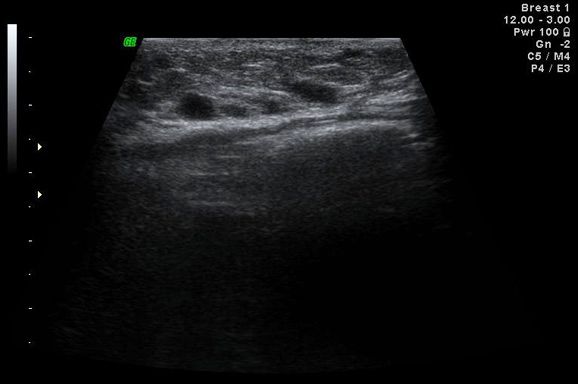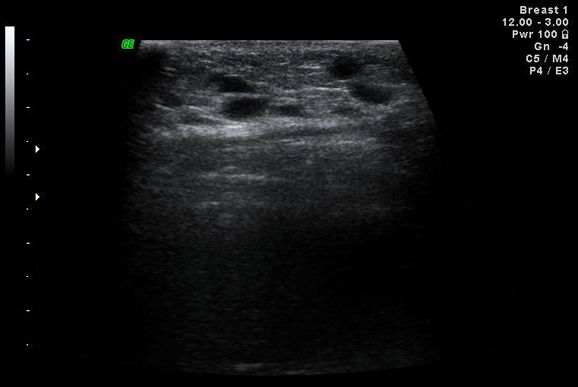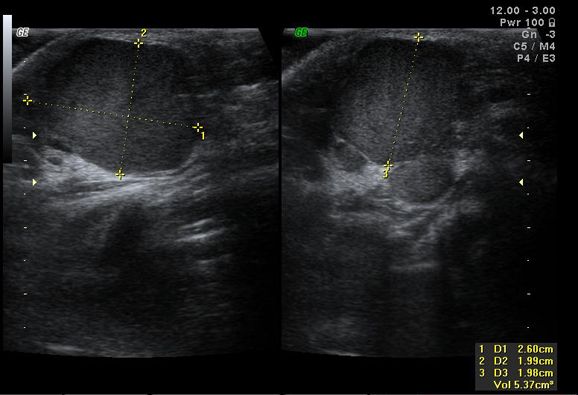Anterior Abdominal Wall Hemangioma in Neonate
Neonate with history of lump in left anterior abdominal wall. Clinical examination showed a lump-like mass with some cutaneous pigmentation.
Case history: Neonate with history of lump in left anterior abdominal wall. Clinical examination showed a lump-like mass with some cutaneous pigmentation.

Figure 1,2 show anaechoic vascular spaces.


Figure 3 power Doppler showed flow in vascular spaces.

Figure 4 haematoma in vascular malformation.
High resolution sonography showed mixed echotexture lesion with vascular spaces with slow flow. Power Doppler showed some flow in vascular spaces. A hematoma was also noted in lump.
Diagnosis: Anterior abdominal wall hemangioma
Hemangioma did not resolve spontaneously and surgical excision was done.
Discussion: Hemangiomas are the most common soft-tissue mass seen in children. Subcutaneous hemangiomas are common benign soft tissue neoplasms that consist of increased blood vessels. These may proliferate rapidly in infancy and may involute later. Some actually consider them to be hamartomas and these may be superficial [capillary or cavernous] or intramuscular [deep] in location or may occur within organs. Hemangiomas can be solitary and sporadic, can be diffuse [known as angiomatosis] or can be a component of various neurocutaneous syndromes such as Von Hippel Lindau and Klippel Trenaunay syndrome.
Ultrasound can be used to distinguish between soft tissue hemangiomas from other vascular malformations and also other masses. In cases of superficial hemangiomas, ultrasound demonstrates a hypoechoic, hyperechoic or mixed echogenicity solid mass usually located within the subcutaneous fat.
The presence of flow within the mass distinguishes it from a non-vascular mass. Once the diagnosis of a vascular mass is made, the differentiation of a hemangioma from other vascular masses can be made if specific criteria are fulfilled. The superficial hemangiomas showed a high number of internal vessels with the feeder vessel usually being identified. These vessels, if arterial, showed a low resistance flow and, if venous, showed a normal venous spectral waveform. A study by Dubois, et al concluded that high vessel density within the mass [> 5 vessels per square cm] and high peak arterial Doppler shift could be used as diagnostic criteria to diagnose hemangiomas.
Most superficial hemangiomas in the infant involute spontaneously, in which case ultrasound offers non-invasive monitoring of these patients; however treatment with flash lamp-pumped dye laser can be offered. In cases of large hemangiomas which may present with consumptive coagualopathy [Kasabach Meritt syndrome], operative measures might have to be considered.
Harpreet Singh, MD
JP Scan private diagnostic center, Khanna, Punjab, India
GE HealthCare Debuts AI-Powered Cardiac CT Device at ACC Conference
April 1st 2025Featuring enhanced low-dose image quality with motion-free images, the Revolution Vibe CT system reportedly facilitates improved diagnostic clarity for patients with conditions ranging from in-stent restenosis to atrial fibrillation.
The Reading Room Podcast: Current Perspectives on the Updated Appropriate Use Criteria for Brain PET
March 18th 2025In a new podcast, Satoshi Minoshima, M.D., Ph.D., and James Williams, Ph.D., share their insights on the recently updated appropriate use criteria for amyloid PET and tau PET in patients with mild cognitive impairment.